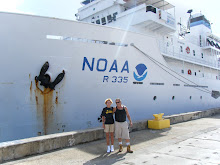 We are into the last day of work before returning to Guam. The first set of BRUVs is being recovered as I write. We will have time for one more set (8) and then we’ll secure the equipment and head for home (home for me anyway―everyone else will still be far from home). Steve is getting great data on the fish populations on the west side of Saipan. As much as we like watching the fish, we got more excited to see a turtle checking the bait, a moray eel chewing on the bait bag, and yesterday, a large tiger shark cruising back and forth nudging the bait bag. Unfortunately, the video ended while the shark was still at the BRUV. When we brought it up, the bait bag was gone.
We are into the last day of work before returning to Guam. The first set of BRUVs is being recovered as I write. We will have time for one more set (8) and then we’ll secure the equipment and head for home (home for me anyway―everyone else will still be far from home). Steve is getting great data on the fish populations on the west side of Saipan. As much as we like watching the fish, we got more excited to see a turtle checking the bait, a moray eel chewing on the bait bag, and yesterday, a large tiger shark cruising back and forth nudging the bait bag. Unfortunately, the video ended while the shark was still at the BRUV. When we brought it up, the bait bag was gone.John and Viv deploy the TOAD each night and make 3 or 4 passes over the
 reef to assess coral coverage and other bottom features. They were particularly happy to have found several areas of reef with the coral Euphyllia paraancora. This coral is found in the tropical Western Pacific and the Indian Ocean, but it is not common. It is heavily harvested for the aquarium trade and more susceptible to bleaching than more robust coral species. It is listed as vulnerable and is further threatened by the predicted threats of climate change and ocean acidification. It was put on the IUCN Red List and is protected via CITES, both as of October, 2009.
reef to assess coral coverage and other bottom features. They were particularly happy to have found several areas of reef with the coral Euphyllia paraancora. This coral is found in the tropical Western Pacific and the Indian Ocean, but it is not common. It is heavily harvested for the aquarium trade and more susceptible to bleaching than more robust coral species. It is listed as vulnerable and is further threatened by the predicted threats of climate change and ocean acidification. It was put on the IUCN Red List and is protected via CITES, both as of October, 2009. 
Above: HARP Diagram
One night we deployed a HARP, a High-Frequency Acoustic Recording Package used to study cetaceans (whales and dolphins). The scientist in charge of this equipment was not onboard but had arranged with the Chief Scientist to put out this equipment near Saipan. This HARP will sit on the seafloor for 2 years collecting sounds. HARPs record ambient ocean noise including low-frequency baleen whale calls, high-frequency dolphin clicks, sounds in between and man-made sounds from ships, sonar, and seismic exploration. When the HARP is retrieved, the sounds can be analyzed and we will learn more about the cetacean populations of the Mariana Islands.
.jpg) A few days ago, Glen gave me a great tour of the engine room. It is beyond the scope of this blog to describe it here, but I can’t resist including a few pictures. I am always amazed by what it takes to keep a ship like this running. They call it an “unmanned engine room” because an alarm will ring if something needs attention like overheating or low oil pressure. It may be called “unmanned” but it takes a lot of man-hours to keep it that way. The engine room and machine shop are really clean and well organized―I didn’t see a drip of oil or a smudge of grease.
A few days ago, Glen gave me a great tour of the engine room. It is beyond the scope of this blog to describe it here, but I can’t resist including a few pictures. I am always amazed by what it takes to keep a ship like this running. They call it an “unmanned engine room” because an alarm will ring if something needs attention like overheating or low oil pressure. It may be called “unmanned” but it takes a lot of man-hours to keep it that way. The engine room and machine shop are really clean and well organized―I didn’t see a drip of oil or a smudge of grease..jpg)
Right: One of 4 diesel engines that provided the electricity for the ship and run the electric motors that drive the propellers..jpg)
.jpg)



No comments:
Post a Comment